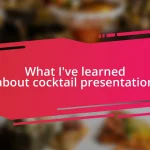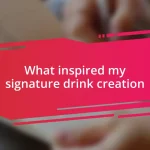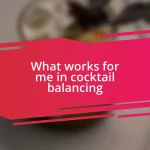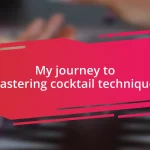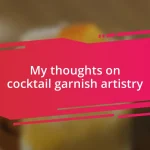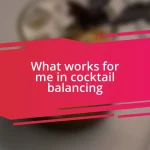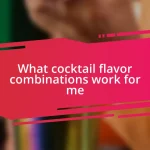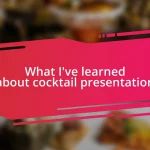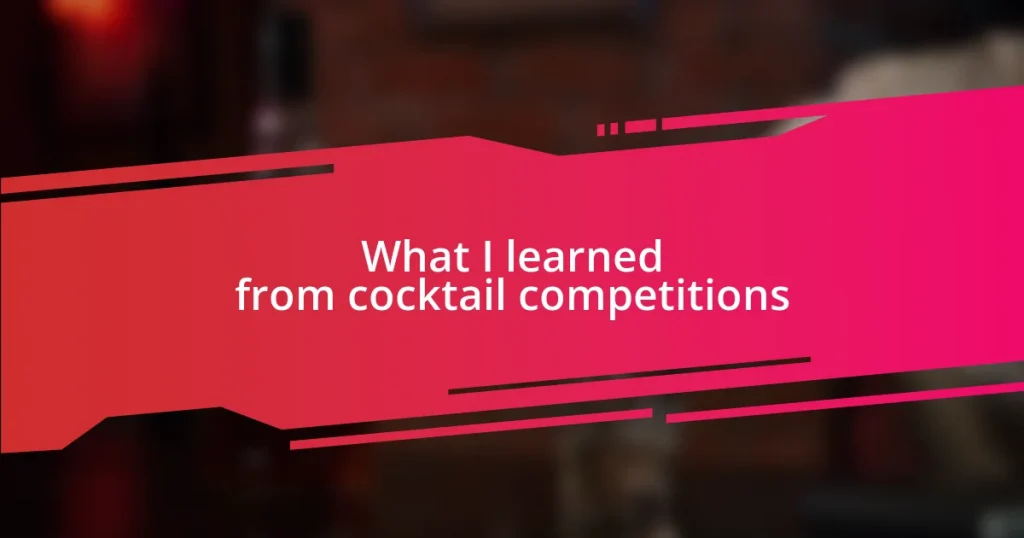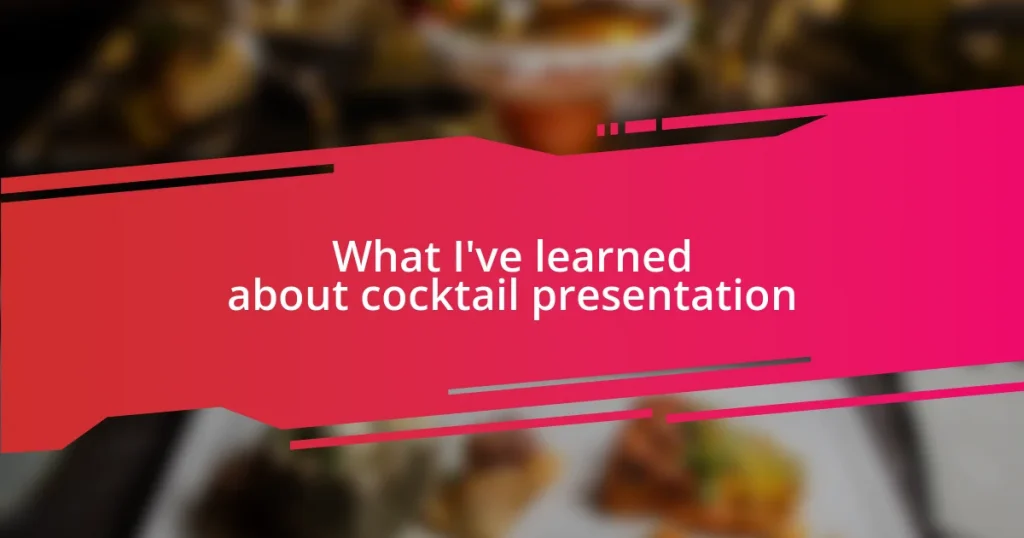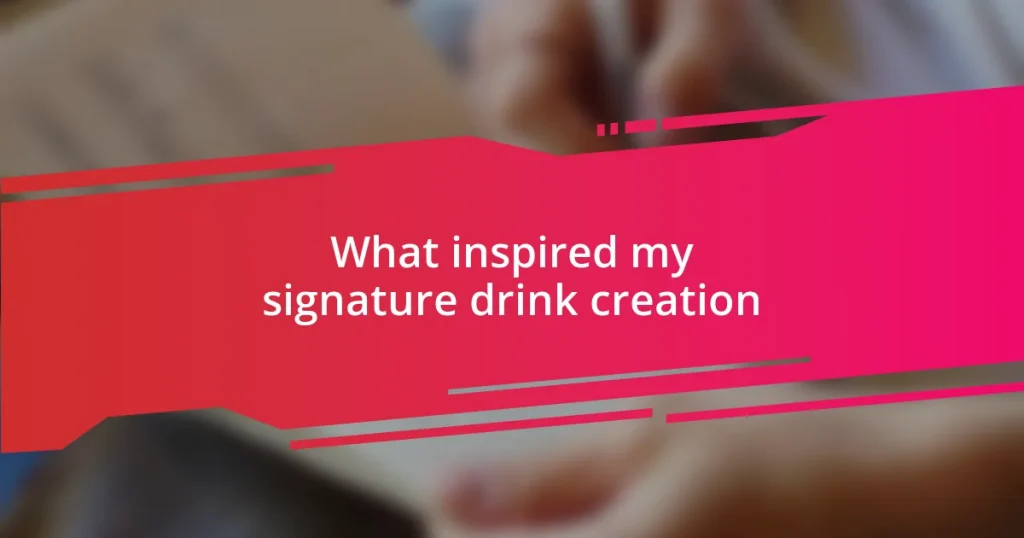Key takeaways:
- Cocktail competitions foster creativity, innovation, and community among bartenders, pushing them to grow personally and professionally.
- Effective preparation involves understanding the competition theme, practicing techniques, creating a signature drink, and focusing on visual presentation.
- Engaging with feedback and critiques is crucial for improvement, as it helps bartenders refine their techniques and enhance the overall quality of their cocktails.
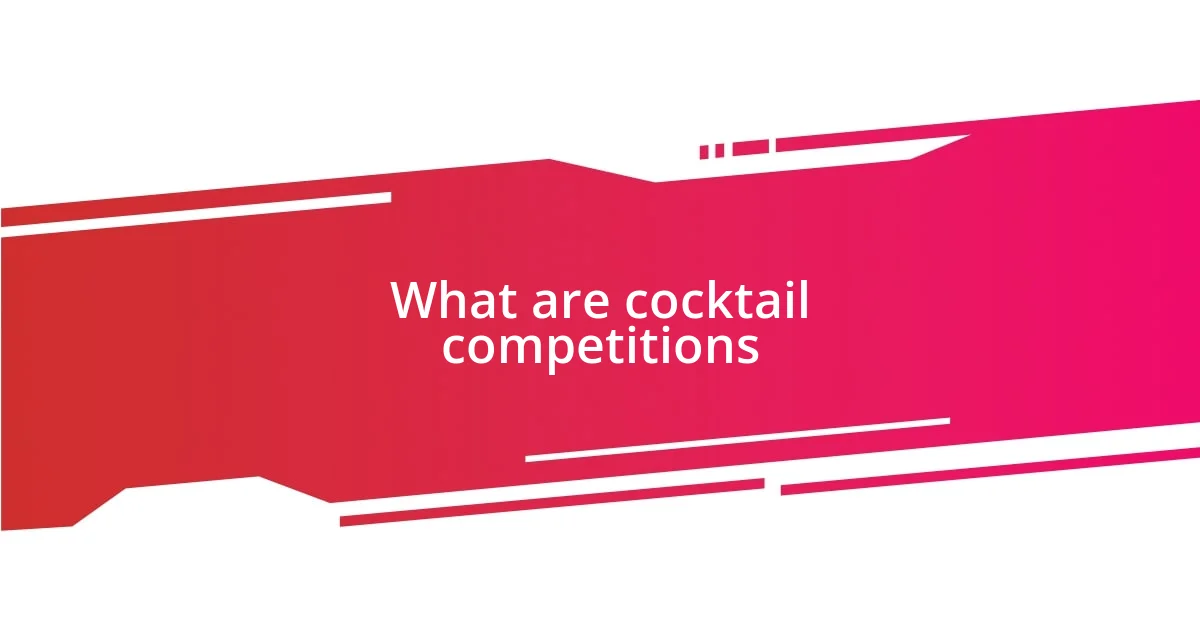
What are cocktail competitions
Cocktail competitions are vibrant events where bartenders showcase their skills and creativity by crafting unique cocktails. I vividly remember my first competition—the adrenaline rush of presenting my drink, knowing there were judges waiting to savor every sip. What better way to test your talents than under the watchful eyes of industry experts and fellow mixologists?
These competitions are more than just contests; they serve as platforms for innovation and networking. Sometimes, when I watch competitors meticulously balance flavors and textures, I wonder how they come up with such original ideas. It’s fascinating to see how these events can foster a sense of community among bartenders, pushing each other to raise the bar.
Moreover, participating in a cocktail competition can be a transformative experience. The pressure can be intense—imagine creating a drink that embodies your style while under the ticking clock. In my case, the thrill of experimentation often fueled my passion and helped me discover new techniques and flavor profiles I’d never considered before. Isn’t it amazing how a competitive environment can spark personal growth and inspire creativity?
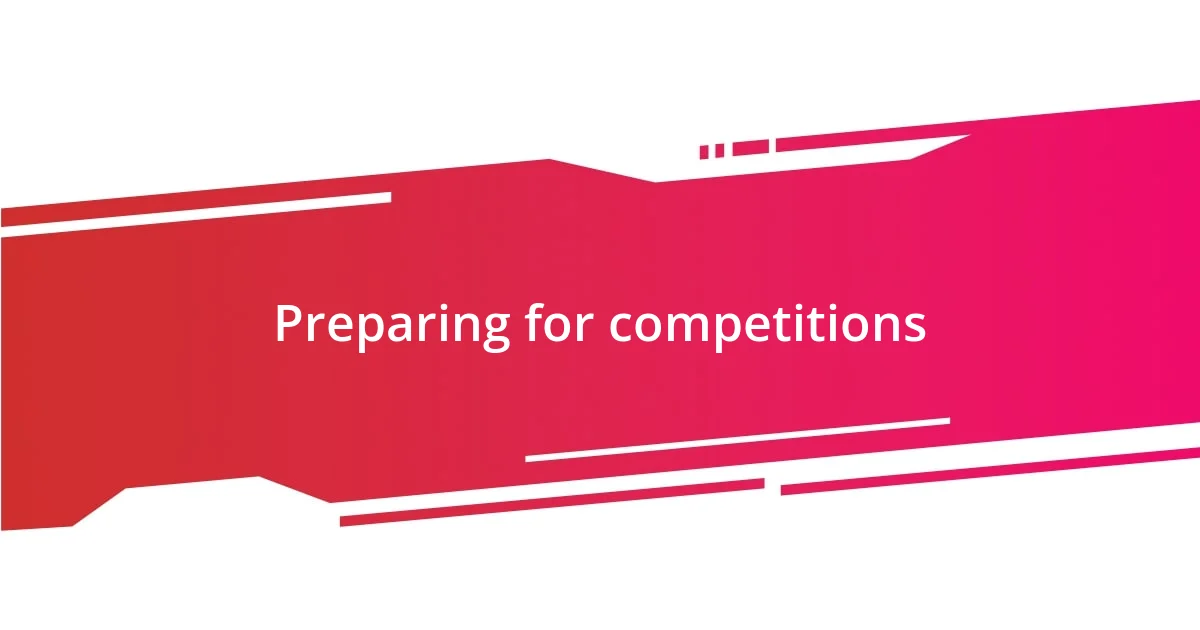
Preparing for competitions
Preparing for a cocktail competition is both exciting and nerve-wracking. I recall meticulously curating my ingredients, ensuring everything was in pristine condition. There’s something about holding that shiny bottle of your favorite spirit that adds to the anticipation. It’s not just about the cocktail; it’s about the story behind it, the flavors you want to convey, and the emotions you hope to evoke in the judges as they take that first sip.
Here’s how I usually prepare:
- Research the Competition Theme: Knowing the theme can guide your cocktail creation process.
- Practice Your Techniques: Get comfortable with time management because precision is key.
- Create a Signature Drink: Your drink should reflect your personality and style—find a unique twist!
- Test Your Recipes: Make multiple versions of your cocktail to perfect the flavors.
- Visual Presentation: Think about garnishes and glassware that will enhance your drink’s appeal.
I also remember the importance of rehearsing my presentation. Standing in front of judges is different from chatting with a guest at the bar. Crafting a captivating narrative while mixing your drink can elevate your presentation from average to unforgettable. Believe me, the right words can complement your cocktail perfectly!
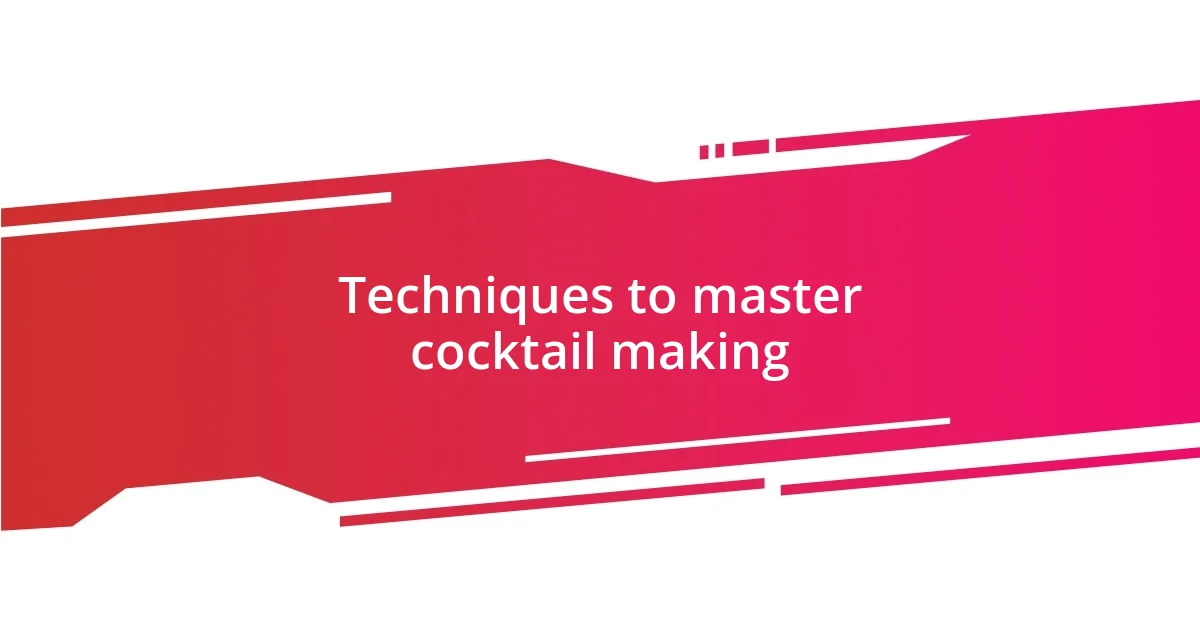
Techniques to master cocktail making
Mastering cocktail techniques is essential for crafting impressive drinks that leave a lasting impression. One technique I’ve found incredibly valuable is shaking to create the perfect texture. The right amount of vigor can aerate the mixture, resulting in a silky mouthfeel that elevates the experience. I still remember the first time I learned to shake properly—my instructor showed me how to control the speed and time, and the difference was night and day!
Another vital technique involves muddling. This is about more than just breaking down ingredients; it’s about extracting flavors without overdoing it. I once over-muddled mint in a cocktail, resulting in a bitter taste that overshadowed the intended refreshing vibe of my drink. Now, I approach muddling with care, aiming for the right balance. It’s like a dance—there’s a rhythm to it that can transform a simple cocktail into something extraordinary.
Finally, garnishing is an art that shouldn’t be overlooked. A well-chosen garnish doesn’t just add visual appeal; it can enhance the drink’s aroma and flavor. I remember experimenting with various herbs and fruits, and realizing that a simple sprig of rosemary completely changed the experience of my cocktail. Paying attention to these smallest details can truly set your cocktails apart and make them memorable.
| Technique | Benefits |
|---|---|
| Shaking | Aerates the drink for a smoother texture |
| Muddling | Extracts flavors without bitterness |
| Garnishing | Adds aroma and visual appeal |
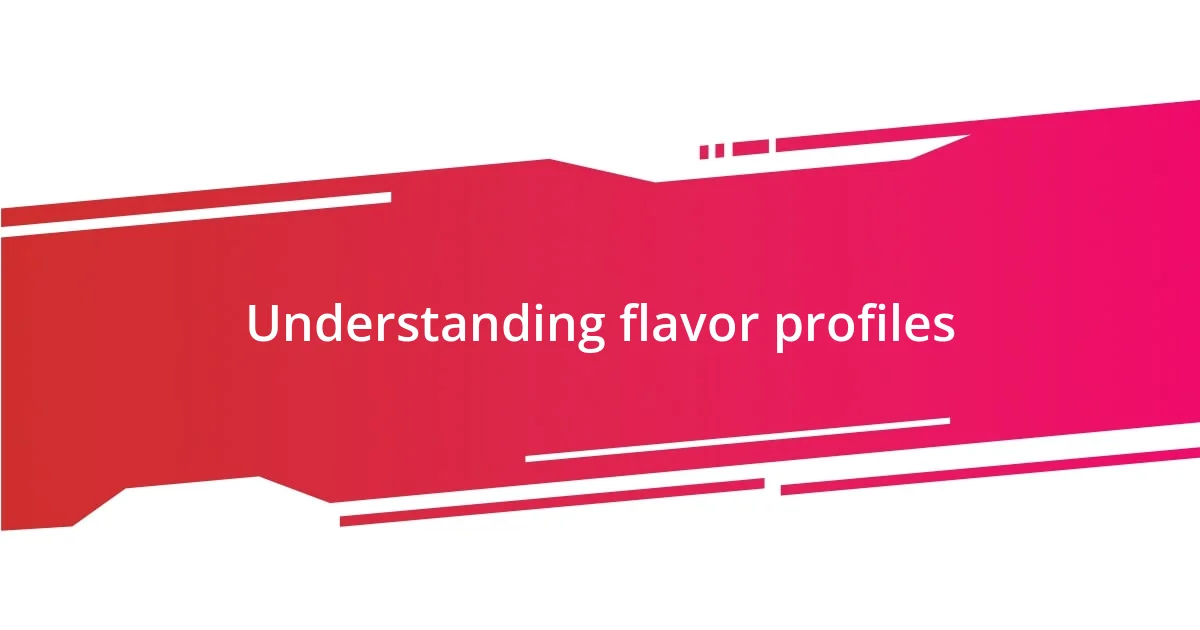
Understanding flavor profiles
Understanding flavor profiles is like entering a world where every ingredient tells its own story. I remember one competition where I experimented with unusual pairings that opened my eyes to new possibilities. Combining smoked rosemary with a citrusy gin brought a depth I hadn’t anticipated, creating a layered experience that intrigued the judges. Isn’t it fascinating how a single herb can transform the narrative of a cocktail?
Exploring the balance between sweet, sour, bitter, and umami can seem overwhelming at first. I found myself questioning how much of each element was necessary to create harmony. During my first cocktail showdown, I added too much sweetness, and the judges picked up on it immediately. From that moment, I learned the importance of restraint and how a delicate touch can elevate a drink to new heights. The journey to master these profiles can be humbling, but every mistake is a stepping stone to greater understanding.
Then there’s the emotional aspect of flavor. Each sip can evoke a memory or feeling that resonates with your audience. I once crafted a cocktail inspired by a summer trip to the beach, using fresh mango and coconut rum. The judges’ smiles as they took their first sips reminded me that flavors can spark nostalgia, creating connections that transcend the glass. How do you want your cocktail to make someone feel? Discovering this can be the heart and soul of your creation.
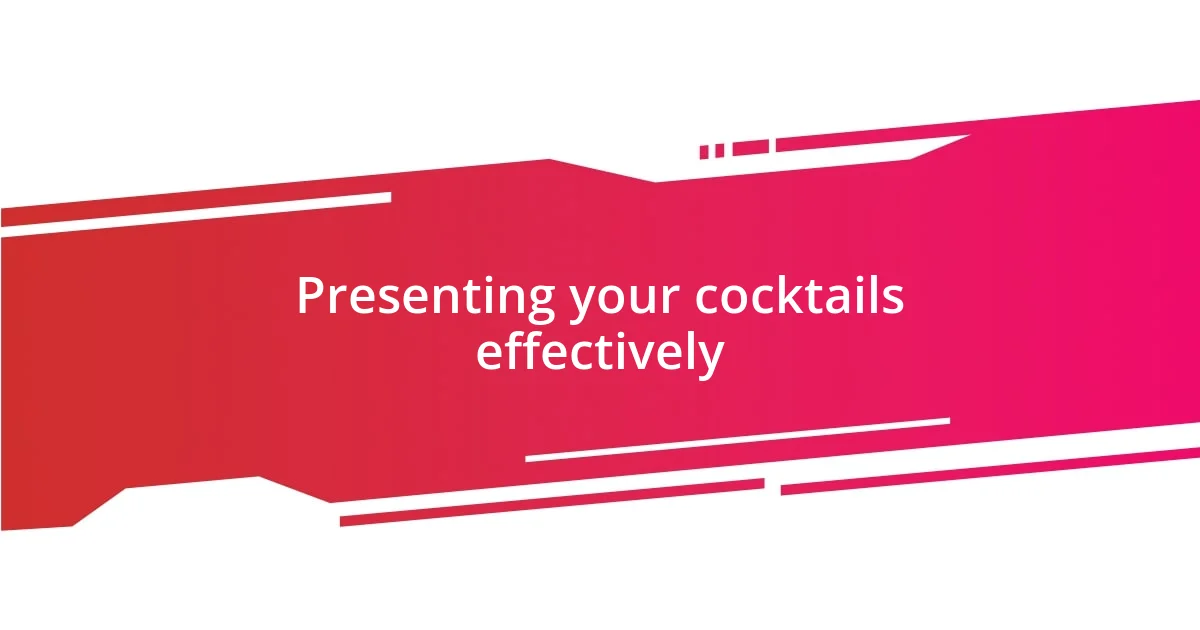
Presenting your cocktails effectively
When it comes to presenting your cocktails, the visual impact is just as important as the taste. I learned this lesson during one competition where I chose to serve a vibrant blue cocktail in a sleek, crystal glass. The moment the judges saw it, their eyes lit up—immediate interest before they even took a sip! It showed me that first impressions matter, and the right presentation can create anticipation for a delightful experience.
Beyond the aesthetics, I discovered the importance of engaging with your audience while you present your cocktail. Sharing a quick story about the inspiration behind the drink or the ingredients used can create a connection. I remember introducing a spiced rum cocktail by recounting a memorable trip to a tropical island. Suddenly, the judges weren’t just drinking a cocktail; they were part of my journey. Have you ever thought about how storytelling can turn a simple drink into a shared experience?
Finally, never underestimate the power of the moment of presentation itself. I found that serving my cocktails with a flourish, like gently placing the garnish or slowly pouring a colorful layer, elevates the whole experience. In one competition, I incorporated a small flame to toast a garnish right before serving. It was like a mini-show, and the looks of amazement on the judges’ faces were priceless. How can you add your own flair? Embracing special moments like these makes every sip unforgettable.
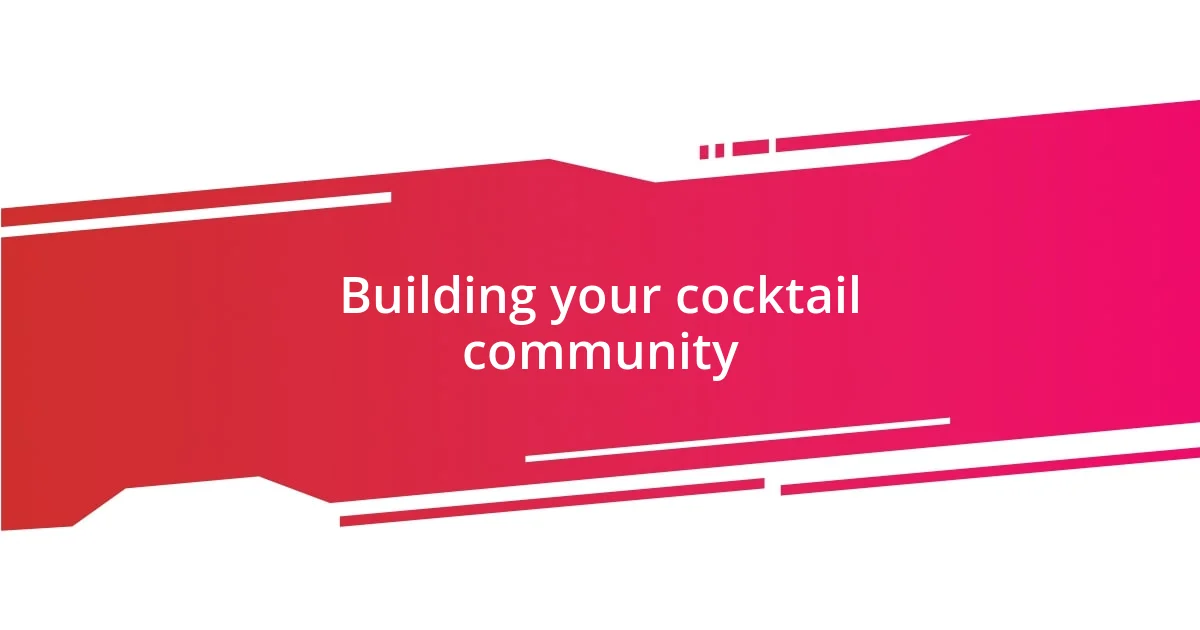
Building your cocktail community
Building a cocktail community has opened up so many doors for me, both personally and professionally. I remember attending my first local tasting event, feeling a mix of nerves and excitement. The moment I shared my favorite gin cocktail with a fellow enthusiast, a spark ignited. We ended up chatting for hours, exchanging recipes and stories, and I realized how invaluable these connections are. Have you ever thought about how a simple conversation can lead to lasting friendships?
As I continued to participate in competitions and local meet-ups, I learned that building relationships within this community is essential. I often found myself reaching out to local bartenders for advice, forming bonds that fostered a genuine spirit of support. Sharing tips, encouraging one another, and celebrating our achievements has enriched my journey immensely. It’s fascinating how collaboration and camaraderie can elevate your craft and create a sense of belonging.
I also found that engaging with social media groups can enhance your cocktail community experience. By sharing photographs of my drinks and discussing techniques, I connected with like-minded individuals worldwide. One week, I posted about a new twist on an old classic, and the feedback I received was heartwarming. It felt great to unite with others who were just as passionate about cocktails. Isn’t it amazing how technology can bridge geographical divides, creating a global haven for cocktail lovers?
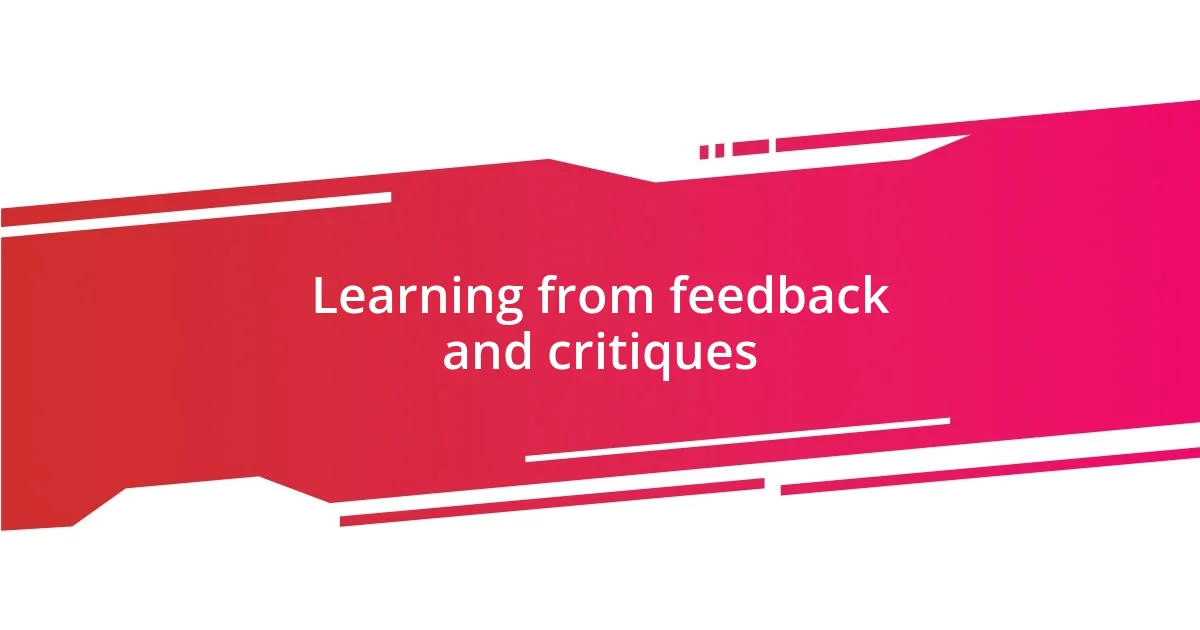
Learning from feedback and critiques
Receiving feedback and critiques during cocktail competitions is a game-changer. After one particular competition, I remember nervously awaiting the judges’ comments on my drink. Their insights were not just constructive; they revealed nuances I’d overlooked. Have you ever experienced that moment when someone points out something you didn’t even realize? It can be eye-opening!
I vividly recall a piece of advice I received about balancing flavors in a cocktail. At first, I shrugged it off, convinced my creation was perfect. However, after tasting it with fresh eyes—and a fresh palate— I understood their perspective. That feedback led me to experiment with adjustments I would have never considered. Isn’t it amazing how the eyes of others can illuminate blind spots in our work?
Listening to critiques is not just about improving a single drink; it’s about enriching your overall approach. My process evolved as I began to embrace feedback like an ally rather than an obstacle. I think back to when I learned that even slight changes, like adjusting the acidity in a cocktail, could lead to a more delightful experience. This journey of learning from feedback has inspired me to become more open and adaptable. How has feedback changed your perspective in a creative endeavor?
